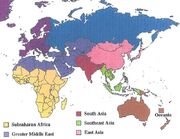Details:[]
- Day: Tuesday, March 15, 2005
- Time: 1:30-3:18 PM
- Location: Hagerty Hall 180
Will Cover:[]
Lectures[]
Know all lecture material from Subsaharan Africa through East Asia. Use the lecture outline handouts and supplemental handouts as guides to your own class notes. Know dates presented in lecture material. Information from guest speakers should also be reviewed.
Readings[]
Study everything listed in the reading guide from Subsaharan Africa through East Asia. If you can answer study questions and know the key terms, you are in good shape with regard to the reading. Remember, you may be asked about information in the reading that was NOT COVERED IN LECTURE.
Calculations from Exercises[]
Level of Urbanization Formula[]
For geographers and others who study urban population patterns, one of the statistics often looked at is "level of urbanization". This refers to the percentage of a population that lives in urban, rather than rural places. Level of urbanization is expressed as a simple percentage as follows:
example: the level of urbanization for a country with a total population of 6 million and an urban population of 3 million would be 50%.
Percent Growth of Population Formula[]
Population growth can be calculated in a number of different ways. It is often expressed as an "average annual growth rate" (such as 1.5% or 3.1%). In this exercise we are using "percent growth of population" over various time periods as our measure of growth. "Percent growth of population" is the change in a population during a particular time period, expressed as a percentage of the population that existed at the beginning of that time period.
example: a country with an urban population of 25 million in 1970 and 125 million in 1990 would have experienced a 400% increase in its urban population during the 1970-1990 time period.
Handouts[]
- Class Handouts
- Supplemental Handouts:
- Nongovernmental Organizations (NGOs) (Subsaharan Africa)
- Middle Eastern City
- Birth Control in Manupur Village (Overpopulation: India)
Place Locations[]

Map of 5 Regions
Know:
- Countries
- Capitals
- Large cities
Click here for a list sorted by region.
Videos[]
- Africa: The Legacy
- Around the World in 80 Days (Michael Palin)
- Harm De Blij Geography Videos
- Cambodia (Khmer Rouge, Pol Pot (1970s))
Examination Format[]
Multiple Choice and True/False Questions
There will be about 35 of these questions on the exam. Questions in the section will be drawn from lectures, readings, videos, class handouts, guest speakers, and Exercises 1 and 2.
Be Prepared to see "all of the above", etc.
Place Locations[]
There will be about 10 place location questions. For these items, you will need to identify cities and countries on the maps of the various regions covered.
Calculations[]
You may be asked to set up a formula to calculate: (see above)
- level of urbanization
- percent growth of population
The above will be asked from you as a table of raw data will likely be included. You will need to write out the formula but not perform the actual calculations.
Short Answer[]
There will be approximately six short answer items (5 points each). In this section, you will be given a term or phrase that you will need to explain. In your answers, you will be expected to draw on information from lectures, assigned readins, class handouts, videos, and the exercises.
Essay Question[]
There will be one essay question (20 points). In your answer, you will be expected to draw on information from lectures, assigned readings, class handouts, vidoes, and the exercises.
You will be given two questions and you will choose one of them.
Bonus Trivia[]
There will 5 fill-in questions dealing with some aspect of the class - trivia questions will likely come from the videos and guest speakers.


